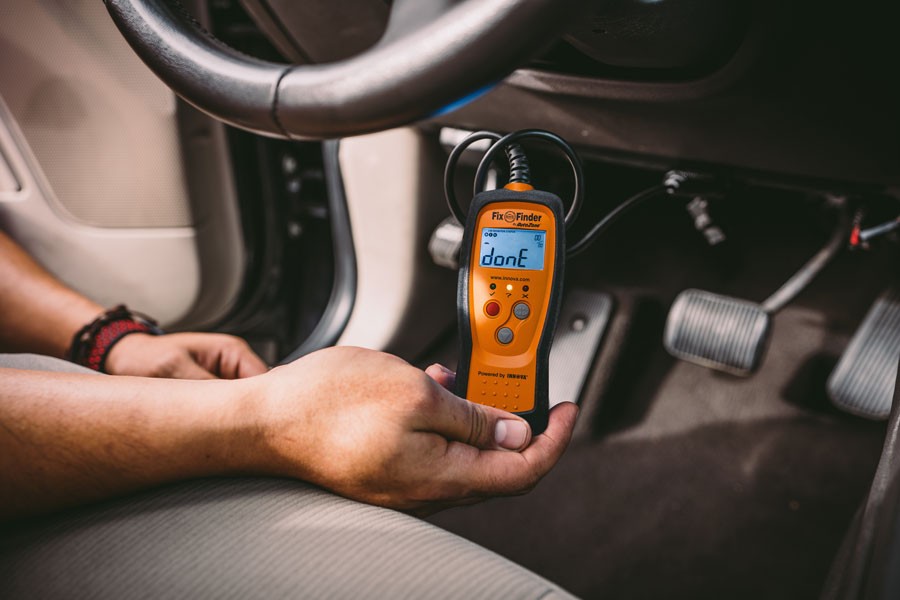Understanding your vehicle’s health is crucial for any car owner, and the On-Board Diagnostics II (OBD2) scanner has become an indispensable tool for this purpose. But what exactly are the Obd Scanner Uses, and how can you effectively utilize this device? This guide will walk you through the various applications of an OBD2 scanner, from connecting it to interpreting the diagnostic trouble codes (DTCs) it reveals, empowering you to take control of your car maintenance.
Locating and Connecting Your OBD2 Scanner: Your First Step
Before exploring the diverse obd scanner uses, you need to know how to connect it to your vehicle. Fortunately, the process is straightforward. Nearly every modern passenger vehicle is equipped with an OBD2 port, a standardized 16-pin connector. You’ll typically find this port located beneath the dashboard on the driver’s side. While in most cases it’s easily accessible there, in some vehicles, it might be tucked away in the center console or under the passenger side dashboard.
Connecting the OBD2 scanner is intuitive. The connector is designed with a trapezoidal shape, ensuring it only fits in one orientation. Simply align the male end of your scanner with the female OBD2 port and gently but firmly push them together. A slight wiggle might be necessary to ensure a secure connection.
Follow these steps to correctly connect your OBD2 scanner:
- Turn off the ignition: Ensure your vehicle’s ignition is completely off before proceeding.
- Connect the scanner: Plug the OBD2 scanner into the diagnostic port.
- Turn ignition to “ON”: Turn the ignition key to the “ON” position. This activates the vehicle’s electrical system without starting the engine.
- Power up: In most cases, the OBD2 port will provide power to your scanner, initiating its boot sequence.
- Wait for initialization: Allow the OBD2 scanner to complete its startup process.
Once connected, your OBD2 scanner may prompt you for additional vehicle information, such as engine size, Vehicle Identification Number (VIN), or instructions to start the engine. Follow the on-screen prompts to proceed.
Navigating the OBD2 Scanner Menu: Unlocking Diagnostic Capabilities
After successfully connecting your OBD2 scanner and it has booted up, you’ll be presented with a menu offering various diagnostic options. The complexity of this menu can vary depending on whether you are using a basic code reader or a more advanced professional-grade scan tool. However, common obd scanner uses accessible through the menu typically include:
- Read Codes: This is a primary function for understanding obd scanner uses. Selecting “Read Codes” will instruct the scanner to retrieve and display any stored or pending DTCs. These codes, often accompanied by a brief description, pinpoint potential issues within your vehicle’s systems. If multiple codes are present, the scanner will usually scroll through them sequentially.
- Erase Codes: Another key aspect of obd scanner uses is the ability to clear codes. By navigating to and selecting “Erase Codes,” you can clear stored DTCs from your vehicle’s computer. Typically, the scanner will request confirmation before erasing codes to prevent accidental deletion. Clearing codes removes the fault data stored in the system.
- Live Data: For scanners equipped with this feature, “Live Data” provides real-time monitoring of various sensor readings. This allows you to observe sensor values as they change, helping identify sensors operating outside of their expected ranges or those that are unresponsive. Examining live data is a powerful obd scanner use for in-depth diagnostics.
- Freeze Frame: This function captures a snapshot of crucial parameters, such as engine speed, coolant temperature, and fuel trim, at the precise moment a DTC was triggered. Freeze frame data provides valuable context and clues related to the conditions under which a fault occurred, enhancing the effectiveness of obd scanner uses in diagnosis.
- Vehicle Info: This option typically displays basic information about your vehicle, such as the VIN and other build-related data.
- I/M Readiness: Short for Inspection and Maintenance Readiness, this feature is particularly useful for emissions testing. It checks the status of various emissions-related systems, indicating whether your vehicle is ready for a smog check or if any faults might prevent it from passing. Checking I/M Readiness is a practical obd scanner use for pre-test assessments.
Navigating these menus is generally done using buttons on the scanner itself, even for Bluetooth or Wi-Fi enabled scanners controlled via smartphones. Arrow buttons facilitate scrolling through menu options, a select button confirms your choice, and often a back button is available to return to the previous menu.
Decoding Diagnostic Trouble Codes: Understanding the Language of Your Car
 OBD-II scanner done reading trouble codes
OBD-II scanner done reading trouble codes
One of the most important obd scanner uses revolves around interpreting the DTCs displayed after selecting “Read Codes.” These codes follow a standardized format: a letter followed by four numbers, for example, “P0301.”
The initial letter designates the vehicle system where the fault originates:
- P (Powertrain): Indicates issues within the engine, transmission, fuel system, and emissions control systems. Powertrain related diagnostics are common obd scanner uses.
- B (Body): Refers to problems in body control systems, such as airbags, power windows, and interior electronics.
- C (Chassis): Signals faults within chassis systems, including suspension, braking, and steering.
- U (Network): Denotes communication or network-related issues within the vehicle’s electronic systems.
The numbers following the letter provide further details about the fault. The first number after the letter is either “0” or “1.” “0” signifies a generic code, standardized across all manufacturers, while “1” indicates a manufacturer-specific code.
The next digit further categorizes the system:
- 1 & 2: Fuel and air metering system faults.
- 3: Ignition system or misfire faults. Misfire detection is a frequent obd scanner use.
- 4: Auxiliary emission control system faults.
- 5: Vehicle speed control and idle control system faults.
- 7, 8, & 9: Transmission-related codes.
- A, B, & C: Hybrid-specific codes.
The final two digits pinpoint the specific component or circuit experiencing the problem. With hundreds of potential combinations, detailed code definitions are crucial for accurate diagnosis.
Let’s revisit our example code, P0301. Based on the breakdown, we can interpret it as:
- P: Powertrain system.
- 0: Generic code.
- 3: Ignition system or misfire.
- 01: Specifically cylinder #1.
Therefore, P0301 indicates a generic powertrain code related to a cylinder #1 misfire.
Maximizing OBD Scanner Uses: Saving on Auto Repairs and Maintenance
Utilizing an OBD2 scanner effectively offers several avenues for saving money on car repairs. Firstly, when the “Check Engine” light illuminates or you experience performance issues, a quick scan can provide initial insights into the potential source of the problem. While it might not pinpoint the exact cause, it serves as a crucial first step in the diagnostic process. This initial assessment is a valuable obd scanner use to avoid unnecessary mechanic visits.
Secondly, the I/M Readiness test can proactively inform you about your vehicle’s emissions system status before a smog check. Identifying potential issues beforehand can prevent failing the test and the associated costs of retesting.
Furthermore, by diagnosing and potentially resolving issues yourself, you can save significantly on both diagnostic and repair costs at auto repair shops. For example, if a scan reveals a P0138 code, indicating a high voltage issue with the bank 1 sensor 2 oxygen sensor, replacing the sensor becomes a viable DIY repair. Being able to clear the code yourself after replacing the sensor completes the repair process efficiently. This DIY approach, enabled by obd scanner uses, empowers car owners to manage repairs more affordably.
Consider investing in an OBD2 scanner from reputable automotive parts retailers to broaden your DIY capabilities. Alternatively, explore loan-a-tool programs offered by some retailers to access scanners without immediate purchase, making obd scanner uses even more accessible.
FAQ: Common Questions About OBD Scanner Uses
How do you use an OBD II scanner?
Simply plug the scanner into the OBD2 port under your dashboard, turn your vehicle’s ignition to the “ON” position (without starting the engine), and follow the on-screen instructions provided by your scanner.
Does the car have to be running to use an OBD2 scanner?
No, in most cases, you can read trouble codes with the ignition in the “ON” position. Starting the engine is usually not required for basic code reading.
How do I read my OBD scanner output?
Select “Read Codes” on your scanner’s menu. Note down any active and pending DTCs displayed. The letter and numbers within the code provide information about the affected system and the specific fault.
Can you plug in an OBD scanner while the car is running?
While technically possible, it’s generally not recommended to plug in or unplug an OBD scanner while the engine is running. It’s best practice to turn the ignition off before connecting or disconnecting the scanner. If you attempt to connect while the engine is running, you might need to cycle the ignition off and back to the “ON” position to initiate the diagnostic test properly.

